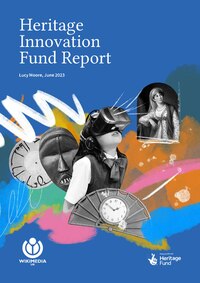GLAM/Newsletter/August 2023/Contents/UK report
|
Islamic art exhibitions and heritage innovation
Khalili Foundation

After previous success with Hajj: Journey to the Heart of Islam, I have worked on documenting more public exhibitions of Islamic art.
- I acquired the printed catalogue of Heaven on Earth: art from Islamic lands, a 2004 exhibition, and checked all the items that came from the Khalili Collections. If an image of the object exists on Wikimedia Commons, I added it to this image gallery. The objects for which we have not yet shared images are listed at commons:Category_talk:Heaven on Earth: art from Islamic lands. These are images we could prioritise in a future bulk upload. The next task is to start a draft Wikipedia article on the exhibition, using this detailed list of content.
- Empire of the Sultans: Ottoman Art of the Khalili Collection was a travelling exhibition held in 16 different locations in the 1990s and 2000s. I found 15 different newspaper reviews of the exhibition and some other news items — plus a statement from US Senator John Edwards — and summarised them in a draft. The catalogue of the exhibition is on its way to me and I will use that to list and summarise the exhibition's content. I have started a gallery at commons:Category:Empire of the Sultans.
I have continued extending and restructuring English Wikipedia's articles on Cultural diversity and Convention on the Protection and Promotion of the Diversity of Cultural Expressions. After a few more changes, the plan is to submit these articles for community review to get ideas for making them even more accessible.
On Wikidata, I have created 22 new representations, including adding paintings from the Khalili Collection of Islamic Art for the Sum of All Paintings data set, drawing from the Heaven on Earth catalogue. There are now 152 paintings from the collection listed in the data set, or which 29 were added in the last two months. Now, for example, if we ask Wikidata for objects related to Mohammad Shah Qajar, it tells us the Khalili Collections have a miniature portrait of him.
The GLAMorgan tool reports 4,520,153 views for Khalili Collections images in August. We always have a drop in image views during Summer holidays, but the drop is more shallow this year.
There are two draft articles for which I'm still waiting for curator feedback on before publishing, but which are pretty much ready to go. There are no new image uploads this month, and no new translations.
A couple of years ago I wrote a blog post about my work describing Khalili Collections manuscripts in Wikidata. This month, Digital Scriptorium — a consortium of researchers from institutions including the University of Oxford and University of Pennsylvania — was recommending the blog post as a starting point for their own work describing pre-modern manuscripts on Wikidata. See this Tweet. I also found out this month that Toby Burrows of the Bodleian Library wrote an academic paper citing the blog post and arguing that Wikidata could be used to create links between many different catalogues of manuscripts.
The Heritage Innovation Fund: exploring barriers to participation

August saw the publication of the report on Wikimedia UK's Heritage Innovation Fund project.
Last year, the National Lottery Heritage Fund set up a funding stream, the Heritage Innovation Fund, to encourage learning, experimentation, and innovation in the heritage sector. Wikimedia UK were one of the successful applicants. Our aim was to find out what barriers to participation groups and organisations face in the cultural heritage sector. Time and money are a given, and we wanted to dig deeper.
The work drew on Wikimedia UK's Connected Heritage project which since 2021 has sought to improve the digital skills of small and medium-sized cultural heritage organisations. The research was carried out by Lucy Moore and involved a mixture of surveys and interviews.
There are a raft of recommendations for how Wikimedia UK can better meet the needs of the heritage sector. They fall into three main categories:
- Advocacy – sharing what has worked, raising the profile of the organisation in the sector, and advancing the case for open access
- Empathy – tailoring our approach to the context of difference audiences and finding ways to accommodate their needs
- Informal education – developing learning resources and signposting them to build confidence
We have started to incorporate these recommendations into our work and will continue to explore how we can better work with the heritage sector. The interviewees were positive about what Wikimedia UK can offer to the heritage sector, so there is appetite for more work with the Wikimedia projects. On a personal note, I was especially pleased that "Six participants commented on the Connected heritage programme specifically, identifying the quality of the training and the warmth of the team as key to enabling them to engage with the offer." The Connected Heritage project is specifically intended for the GLAM sector, and this is testament to the excellent work of Lucy Hinnie and Leah Emary.
The full report is worth a read, and while it is specific to the UK context it may be useful to others working in the GLAM sector. Thank you to Lucy Moore for her exemplary work conducting the research and writing the report. This is an important piece of work for WMUK's relationship with the heritage sector.
- Albania report
- Argentina report
- Armenia report
- Belgium report
- Brazil report
- Canada report
- Germany report
- Italy report
- Kosovo report
- New Zealand report
- Poland report
- Serbia report
- Sweden report
- Switzerland report
- UK report
- USA report
- AvoinGLAM report
- Content Partnerships Hub report
- Structured Data on Wikimedia Commons report
- Wiki Loves Living Heritage report
- WREN at Wikimania report
- Calendar


